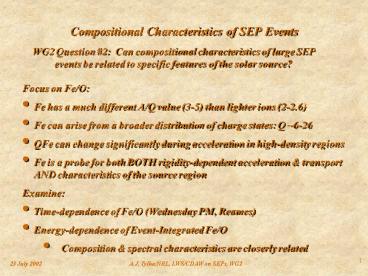Compositional Characteristics of SEP Events - PowerPoint PPT Presentation
1 / 23
Title:
Compositional Characteristics of SEP Events
Description:
Consistent with Bastille Day QFe from SEPICA and SAMPEX. Compare with QFe from other events: 1992 event remarkably similar to Bastille Day event. ... – PowerPoint PPT presentation
Number of Views:33
Avg rating:3.0/5.0
Title: Compositional Characteristics of SEP Events
1
Compositional Characteristics of SEP Events
WG2 Question 2 Can compositional
characteristics of large SEP events be related to
specific features of the solar source?
- Focus on Fe/O
- Fe has a much different A/Q value (3-5) than
lighter ions (2-2.6) - Fe can arise from a broader distribution of
charge states Q 6-26 - QFe can change significantly during acceleration
in high-density regions - Fe is a probe for both BOTH rigidity-dependent
acceleration transport AND characteristics of
the source region - Examine
- Time-dependence of Fe/O (Wednesday PM, Reames)
- Energy-dependence of Event-Integrated Fe/O
- Composition spectral characteristics are
closerly related
2
Heavy-Ion Spectral Variability in Large SEP Events
From ACE News 58 by Tylka, Cohen, Dietrich,
Maclennan, Ng, Reames
3
Fe/O vs. Time -- These plots are available on
the CDAW Event Matrix
14 July 2000
14 July 2000
16 August 2001
4
Energy-Dependence of Event-Integrated Fe/O--
also available on the CDAW Event Matrix
Largest GLE of Cycle 23
5
Event-to-Event Variability in Energy-Dependent
Fe/OCan we find feature(s) of the solar sources
that explain this variability?
6
Events with highly-suppressed Fe/O at high
energies
7
Spectral Origin of Highly Suppressed Fe/O at High
Energies
Event-Integrated O Fe Energy Spectra 24
September 2001 Event
Fits to Ellison-Ramaty Form Fx(E) E-?
exp(-E/E0x)
8
Event-Integrated O Fe Energy Spectra
08 November 2000
20 April 1998
Both O Fe are reasonably well fit by E-R form
except lt 0.5 MeV/nuc But Fe has a smaller
e-folding energy, correspnding to QFe 10.
9
More Event-Integrated Oxygen Spectra
14 July 2000
04 November 2001
22 November 2001
- Reasonably well-fit to Ellison-Ramaty Form
- Morphologically similar to the previous events
10
But very different energy dependence in Fe/O
11
Event-Integrated Iron Spectra
14 July 2000
04 November 2001
22 November 2001
- Not well-fit to Ellison-Ramaty Form
12
Q Why is Fe/O different in these events, even
though oxygen spectra are similar?
95 SW ST
5 Rem. Flare ST
Bastille Day 2000 Event
A Fe are accelerated out of a broader
distribution of charge states in these events,
e.g. remnant flare suprathermals in the source
population.
Tylka et al, Ap. J. Letters, 558, L69-L63, (2001)
13
Implication Energy-Dependent Charge States
Tylka et al, Ap. J. Letters, 558, L69-L63, (2001)
- Consistent with Bastille Day ltQFegt from SEPICA
and SAMPEX. - Compare with ltQFegt from other events
- 1992 event remarkably similar to Bastille Day
event. - 1997 November 6 has very strong energy dependence
below 2 MeV/nuc. - Probably cannot be reproduced by this model.
- Due to stripping in low corona. (Reames et al
1999 Barghouty Mewaldt 1999, 2000 Stovpyuk
Ostryakov 2001). - Another calculation dashed curve
- Same source mixture
- But 10x larger e-folding energies.
- (e.g. Sept 1989 Lovell et al. 1998)
- Agrees with 1989 QFe measurements
14
There are 48 events on the CDAW Event List.So
far, weve looked at 6. Why these 6?
15
Another Problem Whats going on in this event?
16
Complicated behavior not due to multiple
injections!
Hourly Profiles 2001 15 April 0600 UT -18 Apr
1200 UT
17
Many events show similar behavior
- Seen in 25 -50 of large SEP event.
- Appears over a wide range of event sizes
- Appears over a wide range of longitudes
18
Event-Integrated Energy Spectra in the 15 April
2001 Event
19
A Clue Energy-Dependent Fe Charge States ?
( Limited ) geomagnetic measurements from
SAMPEX Indirect measurements from Time-to-Maximum
Analysis (Dietrich Tylka, 2002)
- SAMPEX Charge State Measurements
- MAST Labrador et al., Spring 2002 AGU
- LICA Mazur et al, Fall 2001 AGU
20
Not all events show dramatic energy-dependence in
Fe/O
(Biggest Flare in the CDAW List)
(Distant Backside Source?)
21
Hypothesis Two types of large SEP Events,
--based on spectral, compositional, and QFe
characteristics
- Type A (eg., 20Apr98, 14Jul00)
- Ellison-Ramaty spectra, except for
transport-distortions at low energies - Fe/O generally falls with increasing energy
- Trivial energy dependence in QFe , indicating
acceleration occurred only in low-density
regions. - The largest events fall in this category.
- Type B (e.g., 15Apr01)
- Power-law spectra, apart from transport-distortion
s at low energies. - knees presumably at event higher energies
- Fe/O rises with increasing energy, due to harder
Fe spectrum - Strong energy dependence in QFe, perhaps due to
stripping during acceleration in a high-density
region
(WG1) Are there observable differences in the
characteristics of the solar sources? For
example, in timing, indicating acceleration
beginning at different coronal altitudes? (WG2)
What physics factors govern the spectral/size
characteristics?
22
Detour What about flare-accelerated (a.k.a.
impulsive) events?
14 April 2001 The Largest Impulsive Event of
Cycle 23 (?)
Additional information ACE/ULEIS 3He/4He 10
in 14Apr01 Event, lt2 (upper limit) in others
23
The 14 April 2001 Flare-Accelerated SEP Event
- Fe O spectra nearly identical over entire
energy range - Fe/O strongly enhanced at 12x coronal
- Timeto-Maximum independent of species all
fully-ionized.
Inferred Charge State ltQFegt 25.8 2.3































